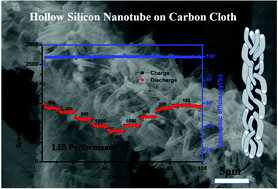Hollow-structure engineering of a silicon–carbon anode for ultra-stable lithium-ion batteries†
Abstract
Silicon has received much attention due to its high theoretical capacity as the electrode of lithium-ion batteries (LIBs). However, the poor stability caused by the volume expansion problem affects the cycle life of batteries, thus severely limiting the application of the silicon anode. In the present work, we engineered silicon nanotubes with hollow-structure to accommodate the volume expansion of silicon and improve the electrochemical stability of lithium ion batteries. Hollow silicon nanotubes were in situ synthesized on carbon cloth (HSiNTs/CC) by reducing silicon oxide and corroding zinc oxide nanorod templates and directly used as the anode of lithium-ion batteries without any binders or conductive additives. The results of electrochemical measurements indicated that HSiNTs/CC exhibits superior LIB performance with excellent cycling stability and good rate capability. At a current density of 100 mA g−1, a reversible capacity of 1420 mA h g−1 was achieved and the fabricated LIB could retain 93.7% of the initial capacity after 100 cycles. Even at a decoupled current density of 1000 mA g−1, the LIB still possesses a capacity of 1026 mA h g−1 and 98.3% capacity retention after 100 cycles. The results demonstrated that the thin hollow structures were well suited to accommodate the volume expansion of silicon and improve the stability of the HSiNTs/CC anode during the lithiation–delithiation cycles, which shines some light on the reasonable design and preparation of silicon anodes for ultra-stable lithium-ion batteries.



 Please wait while we load your content...
Please wait while we load your content...